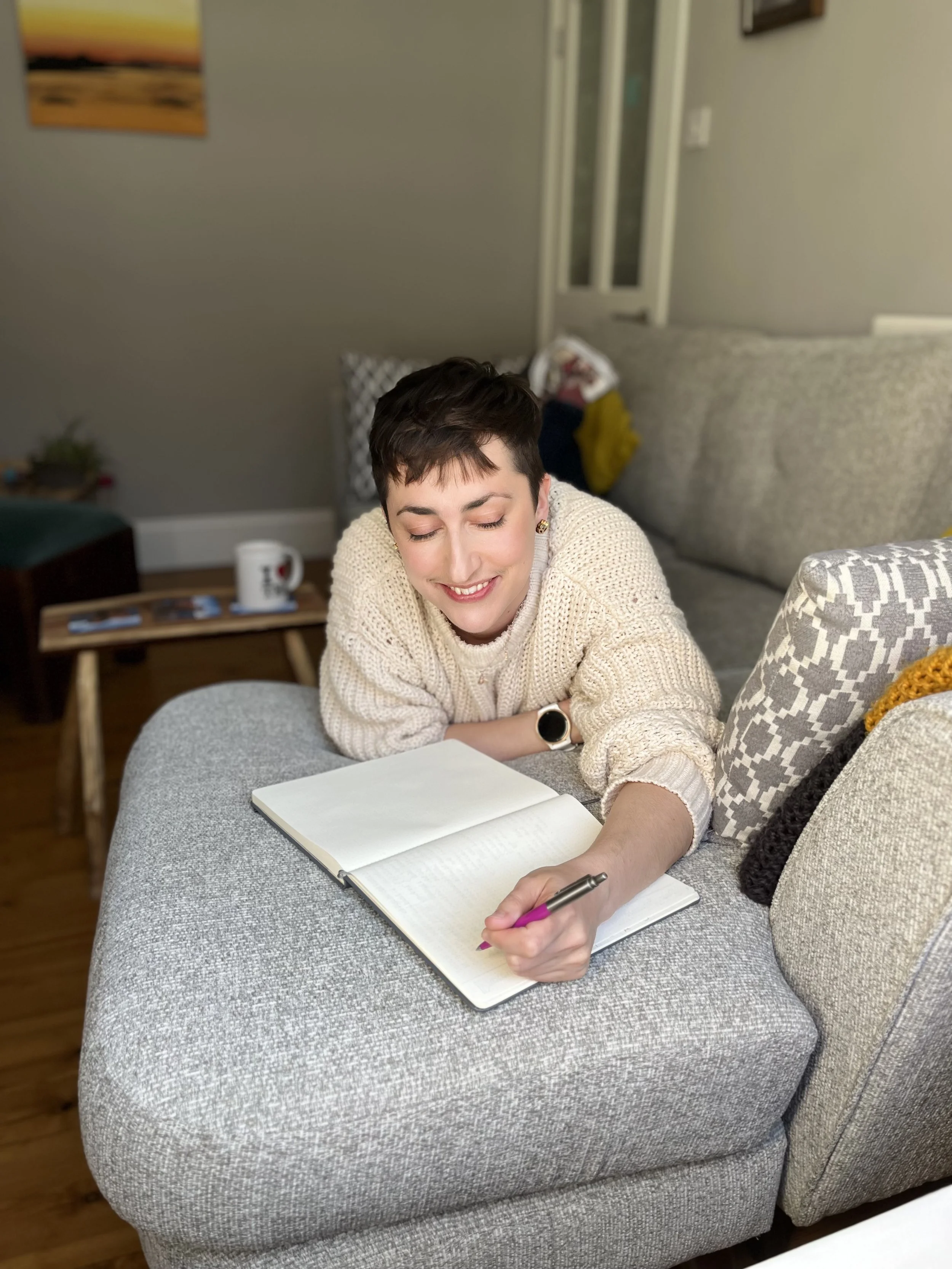7 Types of Rest for the School Day
What could rest look like for you in school?
Journaling is one way that I find rest and space to reset
Thank goodness it’s half term!
Many of the school leaders I have been working with recently have expressed exhaustion and disbelief that this term could have been 8 weeks long (you’d hope there would be a law against that, right?).
But now that it’s half term, you can finally rest and give yourself the well deserved break that you have earned.
I know there will still be things on your to-do list to complete over half term and perhaps these are necessities. However, do give yourself permission to simply switch off for the holidays. If you would like some tips on this, do check out this blog.
Nevertheless, I am here to share with you that rest is not just for half term breaks. And it is definitely NOT just for the summer holidays either. Functioning under continual stressful situations can have a significant impact on your health. The charity, Mind, reports that you can be left feeling:
Irritable, angry, impatient or wound up
Over-burdened or overwhelmed
Anxious, nervous or afraid
Like your thoughts are racing and you can't switch off
Unable to enjoy yourself
Depressed
Uninterested in life
Like you've lost your sense of humour
A sense of dread
Worried or tense
Neglected or lonely
Existing mental health problems getting worse
Rest and taking time out for yourself during the school day may help alleviate some of these symptoms. When we think of rest, we often think about sleep and getting more of it. Yet, when you are experiencing stress, one of the things it can impact most significantly is sleep.
However, there are other ways of resting and crucially, there are ways that you can bring them into your school day.
It will involve taking out some time for yourself during the day.
It will involve putting in some boundaries.
It will involve putting the spotlight on yourself and saying, “I deserve this”.
So, here are the 7 types of rest and how you can incorporate them into your school day.
(Keep reading to see how you can incorporate more than one type of rest at a time!)
1) Physical rest
Cats do have it easy, don’t they?
Physical rest is about listening to what your body needs, and giving this to it. At its simplest, it may be having a nap or a good night’s sleep. Now, these are probably unlikely at school (although I did once fall asleep in my car during my lunchbreak at a job before teaching!) so you may need to think outside of the box.
What you want to be exploring are forms of active physical rest.
Here’s how:
Stand up, away from your desk and stretch!
Stretch your arms above your head. Stretch your legs, one at a time.
Yawn widely, taking in lots of oxygen.
Shake your body, Taylor Swift style.
Get your body moving.
And lastly, BREATHE.
If it is comfortable for you to do so, take 3 deep breaths and allow yourself to relax for a moment.
2) Mental Rest
Our brains are continually on the go, thinking things through, making decisions and solving problems. That sense of overwhelm that can hit you after a full day of school is an indicator of mental tiredness: your brain is saturated and cannot take in anything further.
Give your brain a break.
Here’s how:
Schedule a 2 minute break each hour. If you’re in the classroom, give yourself a minute before letting the next class in. If you’re in your office, stand up and step away from your desk for a couple of minutes.
Look out the window.
What can you see?
What can you hear?
What can you feel?
Wouldn’t this be a lovely view from your classroom window?
You can combine this with your physical rest and enjoying a good stretch for your body, and your brain!
3) Sensory Rest
Taking time during the school day to “unplug” is crucial for reducing the chances of sensory overload. This can be caused by bright lights or looking at computer screens all the time. Yet, it can also be caused by the regular “ping” of email notifications or the phone ringing.
Nothing to see here…
Here’s how:
Where possible, switch off your notifications. Decide that you choose when during your school day you check your emails, not when others demand your attention.
Also, find small opportunities during the school day to go hide. Take yourself to spaces where you briefly won’t be found, just for a couple of minutes. You could make an adventure out of finding the places no one will think to come looking for you just to have a couple of minutes of respite, and a walk!
4) Emotional Rest
One of the boundaries types that I often speak about are Emotional Boundaries. These are the most challenging to define, explain and put in place.
Teaching is one of those jobs that can be incredibly draining because of the impact it can have on your emotions. It demands that you keep caring, putting the needs of others ahead of yourself and consistently show up for others.
Emotional rest is taking a moment to register how you are feeling and what you need in that moment. It can also be expressing your emotions honestly and authentically. If you’re not okay, you don’t have to pretend that you are. This can feel particularly challenging in school but there are ways to achieve this.
Here’s how:
At points where you don’t feel okay and need that space to offload, find a colleague or someone in school who can be (and is willing to be) someone you can empty your bucket with and leave feel lighter.
This isn’t about that person taking on your load and carrying it themselves.
It’s not about them problem solving either.
It’s simply about being listened to, and heard.
“What do you think, feel or want to say today?”
This is, in part, what I do for my supervision clients.
If this isn’t an option for you in your school, take a piece of paper, set a 5 minute timer and journal using the prompt, “What do you think, feel or want to say today?” This way, you can offload and process how you are feeling independently. Once you’re done, you can go one cathartic step further and shred the paper, if you like.
5) Social Rest
Find the people in school who lift you up
Do you ever notice that after some lessons you can feel enthused and energised but after others, you can feel drained, like you have run a marathon? You can even experience this after speaking with certain colleagues or sitting in certain meetings. There are the Moaning Myrtles where everything is doom and gloom. Then there are the Joyous Joans who endeavour to support and lift others up, laughing and joking on the way.
Social rest is about being around those people who lift you up, help you to be yourself and be the best version of yourself. Typically, these people will be our close family and friends but you can find this at school too.
“Find the Joyous Joans in your school”
Here’s how:
Avoid the Moaning Myrtles at all costs. If you must interact with a Moaning Myrtle, keep it professional, pleasant and swift.
Spend time with Joyous Joans. Find your own Joyous Joan and make sure they are the person to go to when you fancy a coffee break and a quick chat (Also, actually make time for these opportunities during the school day).
6) Creative Rest
Creative rest isn’t just about getting your creative juices flowing and making a new classroom display. And you don’t have to be an Art teacher to get creative either. Creative rest is about reinspiring yourself and finding the joy and awe in life in your school day. It can involve getting out into nature and spending your time in areas of natural beauty although, this is probably not likely in your school day!
Crucially for you, creative rest can massively improve your problem solving capacity and ability to find joy in the potential drudgery that school life can sometimes create.
Stunning but unlikely to be seen from your classroom window
Here’s how:
Collate a small collection of photos, images or music to refer to when you are feeling creatively flat. You could keep these in your teacher planner or you could make a playlist of songs that help you to feel pumped and on top of the world. (If you’re feeling brave enough, have a sing-along too!)
Return to these anytime you are needing a pick-me-up or a bit of inspiration.
Alternatively, get out of your classroom and go for a walk. Schools are some of the best sources of inspiration. Get out and go see other classrooms and focus on the creative inspiration and joy only. Comparison-itus is unwelcome in this abundant space.
7) Spiritual Rest
Lastly, there is spiritual rest. This often refers to activities that bring meaning to your life, such as volunteering or community involvement. Yet, education is one of those jobs that we do because of the purpose it gives us in our lives. You feel that you are helping others, doing something for the children in your care and so are a part of the wider community.
Yet, school can feel so draining and so similar to being stuck on a hamster wheel that sometimes, we can lose sight of why we’re doing it in the first place. So, how can you achieve spiritual rest in school?
Here’s how:
Reconnect to your why.
Check in with yourself:
Why do you do the job that you do?
What gets you out of bed in the mornings?
What are you doing this for?
You can combine this with your Creative Rest and have an image with you that reminds you of your why and that resonates with you, lifting your spirit.
This form of rest can go either way. It can help you to reconnect to your why and reenergise you to go again at school today.
On the other hand, it may also show you that the why that got you into teaching in the first place has expired. It no longer resonates with you or is not a strong enough why to restore you and bring you back into the joy of teaching. And that’s okay. There is no failure in that. It’s just one of those things. It may even help clarify some niggling thoughts that you’ve been having recently.
So, there you have it. 7 types of rest, all within the school day.
This list is designed to be achievable within your school day. Remember, you can only pour from a full cup. So, look after yourself so that you can keep being there for your staff and students.
I’d love to hear how you go with these types of rest! Leave me a comment below with your reflections and further ideas.






